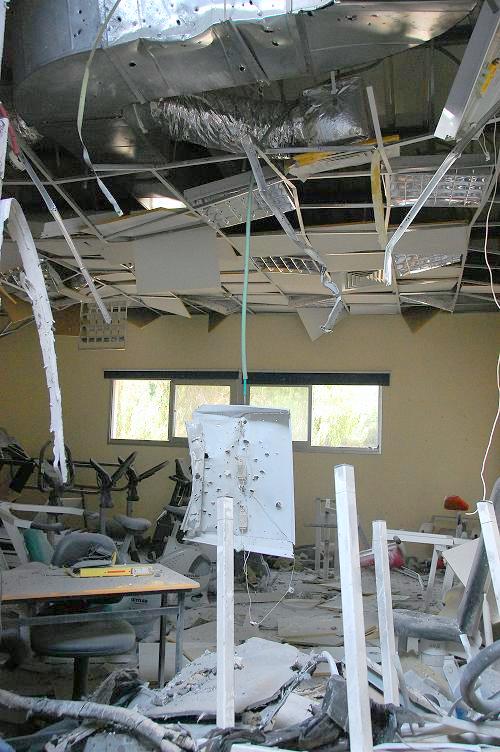Residents of Ashkelon, Sderot say nothing has changed since Operation Cast Lead: Qassams, mortars continue to explode in area; kindergartens and schools still unfortified. Hamas could have been crushed; unfortunately, this wasn’t done,’ says Ashkelon Mayor
On a clear day, Reuven Mahluf can see the Gaza Strip from his home in Ashkelon. During Operation Cast Lead he followed the activity from his balcony, hoping that the missiles hitting the southern city would turn into a distant memory at the end of the operation.
“I saw it all before my eyes, the Qassams they fired here. At the time we thought it was worth suffering all this fire in order to put an end to it,” he says, disappointed. “Who would have thought that two years later a Qassam missile would explode next to a kindergarten? It’s a shame, they could have ended it.”
Two years after the Israeli operation in Gaza, most kindergartens and educational institutions in Ashkelon remain unfortified, while residents of the rocket-battered city feel that the military move missed its target.
“I know that he’s in an unfortified kindergarten and has to cling to the wall of an old building constructed in the 1950s,” says Orly Shmaltz of her three-year-old son.
Occasionally, she hears a rocket alert from the city’s southern industrial zone or from nearby communities, and doesn’t know what to do as her house isn’t fortified either.
“I was sure it would be over after Operation Cast Lead, but there are still sirens and the fear is the same fear,” says Sarit, whose son studies in the same kindergarten. Last week, after a rocket landed near a different kindergarten, she decided that her son would stay at home. “I was scared and filled with anxiety,” she explains.
The rocket near the kindergarten was preceded by a rocket which hit the fields of the Ashkelon Coast Regional Council. Nissim Levy, a local resident and former Shin Bet official, believes that by allowing the “drizzle” of rockets Israel is losing its deterrence skills.
“It’s definitely a missed opportunity. The feeling is that we failed to complete the work,” he explains.
Ibrahim al-Karnawi, a Rahat resident employed in a local kibbutz kitchen, doesn’t see the end either. “There are still rockets, unfortunately. The fact is that a rocket exploded here last week. We thought it was over, but the fire continues.”
Qassam attack (Photo:Noam Bedein)
Despite the High Court’s decision not to force the State to fortify educational institutions in the city, Ashkelon is still struggling: Mayor Benny Vaknin has been travelling abroad in a bid to raise funds from Jewish communities for portable shelters, which would provide a partial solution for the residents’ distress.
“As far as we are concerned, it’s clear that progress has been made. Unfortunately, the promise to fortify the educational institutions has not been fulfilled,” says Vaknin. “It feels like a missed opportunity. Hamas could have been crushed, and unfortunately this wasn’t done.”
Local residents gather at Rose Hatab’s coffee shop, expressing their discontent with the ongoing situation. “There is some calm now, but we still hear sirens and rockets are fired, and it just won’t end. It’s a shame, because people here feel it’s about to return big time,” says Hatab.
Real estate drive clouded by Qassams
The Shaar Hanegev Regional Council and the city of Sderot are experiencing a real estate drive, but the number of security-related incidents in the areas has grown tenfold in the past six months, with 283 incidents (including rockets, mortar shells and infiltration attempts) taking place in November alone.
“The operation has had a positive effect – there is a rise in the number of families asking us to take them in, but on the other hand we are constantly reminded of the fact that the relations with our neighbors have yet to be resolved,” explains Noam Shtehal. “Once every two weeks we experience a siren, rocket fire and infiltration attempts.”
“In 2010 we saw a rise in the number of incidents and a higher involvement of Hamas, along with a desire to bring about an escalation,” adds Shaar Hanegev Regional Council head Alon Schuster.
“The main problem is the unbearable gap between the policy makers’ perception of reality and the fact that the confrontation line has not changed. So we are still struggling to have some of the unfortified communities fortified, see the Iron Dome placed here and not have the aid to the communities frozen.”
Sderot’s residents aren’t happy with the situation either. “As far as we are concerned, the operation wasn’t completed because Hamas’ leaders were not hit. There is no doubt that they should have continued the operation… We have no complaints to the IDF, but the policy makers should have let them complete the work,” says a customer at Sasson Sara’s grocery store.
“It’s true that there is an improvement, a rise in real estate prices and a demand for apartments, but the public strength here needs to be reinforced,” says Sderot Mayor David Buskila. “We expected a complete halt in rocket fire in the region, and that was our feeling, that the end is here. In practice, last month saw 35 launches of mortar shells and Qassams, more than one a day. This month is no different.”
But there are those who believe the situation is improving despite the ongoing fire. “In the past no one would come here in the evenings, children’s birthdays would not be celebrated because people were afraid. Now people come here from out of town, and it’s a sign that the situation is much better,” says Ran Azran, one of the owners of Café Tova’leh.
He admits, however, that “every rocket alert brings back the feelings of fear.”











